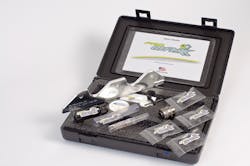Ask the Expert: What causes an exhaust manifold stud/bolt to break?
Q: What causes an exhaust manifold stud/bolt to break?
A: The exhaust manifolds are formed from the factory using fine grain cast iron, and like most metals, it expands and contracts during duty cycles of heating and cooling. This expansion happens naturally, and at first, the manifold and mounting studs are in a state of “elastic deformation.” Elastic deformation is basically expansion and contraction over a period of time retaining the original size and shape. Each duty cycle will provide tension stress on the studs or bolts that hold the manifold in place. The mounting hardware exhibits flexibility over time. However, as the manifold continues to expand and contract more dimensionally, each consecutive time creates larger and larger tension forces that move beyond the elastic state of deformation and become what is referred to as “plastic deformation.” Basically the manifold stretches beyond return and fractures the mounting stud, leaving the manifold permanently deformed and dimensionally changed. This expansion and stretching of the manifold bolts over numerous duty cycles eventually causes too much tension on the bolt(s), stretching them beyond capacity and causing them to fail.
Information provided by: ProMAXX
